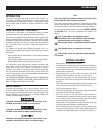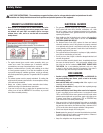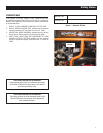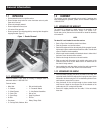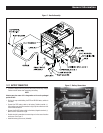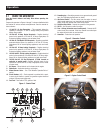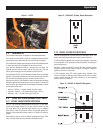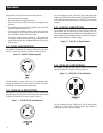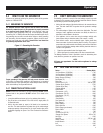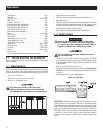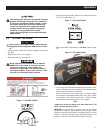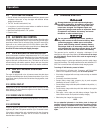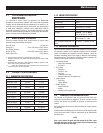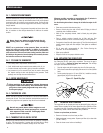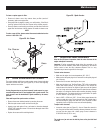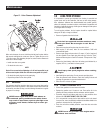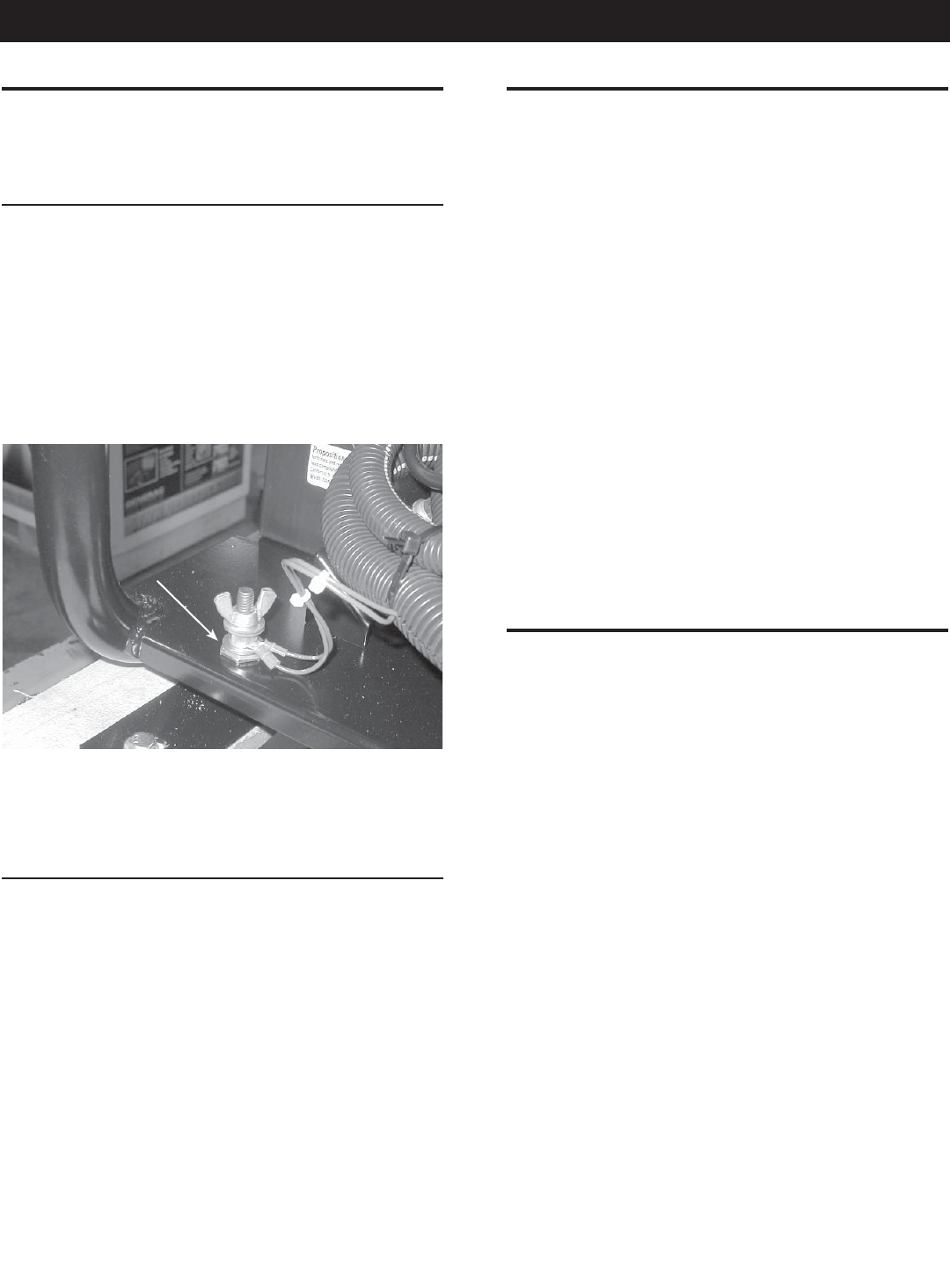
9
2.4 HOW TO USE THE GENERATOR
If there are any problems operating the generator, please call the generator
helpline at 1-888-436-3722.
2.4.1 GROUNDING THE GENERATOR
The National Electrical Code requires that the frame and external
electrically conductive parts of this generator be properly connected
to an approved earth ground (Figure 14). Local electrical codes may
also require proper grounding of the unit. For that purpose, generally,
connecting a No. 10 AWG (American Wire Gauge) stranded copper wire to
the grounding wing nut and to an earth-driven copper or brass grounding
rod (electrode) provides adequate protection against electrical shock.
However, local codes may vary widely. Consult with a local electrician
for grounding requirements in the area.
Figure 14 - Grounding the Generator
Proper grounding of the generator will help prevent electrical shock
in the event of a ground fault condition in the generator or in connected
electrical devices. Proper grounding also helps dissipate static electricity,
which often builds up in ungrounded devices.
2.4.2 CONNECTING ELECTRICAL LOADS
DO NOT connect 240 Volt loads to 120 Volt receptacles. DO NOT connect
3-phase loads to the generator. DO NOT connect 50 Hz loads to the
generator.
• Let engine stabilize and warm up for a few minutes after starting.
• Plug in and turn on the desired 120 or 240 Volt AC, single phase, 60
Hz electrical loads.
• Add up the rated watts (or amps) of all loads to be connected at
one time. This total should not be greater than (a) the rated wattage/
amperage capacity of the generator or (b) circuit breaker rating of the
receptacle supplying the power. See "Don't Overload the Generator"
below.
2.5 DON’T OVERLOAD THE GENERATOR
Overloading a generator in excess of its rated wattage capacity can result
in damage to the generator and to connected electrical devices. Observe
the following to prevent overloading the unit:
• Add up the total wattage of all electrical devices to be connected at one
time. This total should NOT be greater than the generator's wattage
capacity.
• The rated wattage of lights can be taken from light bulbs. The rated
wattage of tools, appliances and motors can usually be found on a
data label or decal affixed to the device.
• If the appliance, tool or motor does not give wattage, multiply volts
times ampere rating to determine watts (volts x amps = watts).
• Some electric motors, such as induction types, require about three
times more watts of power for starting than for running. This surge of
power lasts only a few seconds when starting such motors. Make sure
to allow for high starting wattage when selecting electrical devices to
connect to the generator:
1. Figure the watts needed to start the largest motor.
2. Add to that figure the running watts of all other connected loads.
The Wattage Reference Guide is provided to assist in determining how
many items the generator can operate at one time.
NOTE:
All figures are approximate. See data label on appliance for wattage
requirements.
2.6 WATTAGE REFERENCE GUIDE
Device . . . . . . . . . . . . . . . . . . . . . . . . . . . . . . . . . . . Running Watts
*Air Conditioner (12,000 Btu). . . . . . . . . . . . . . . . . . . . . . . . . . 1700
*Air Conditioner (24,000 Btu). . . . . . . . . . . . . . . . . . . . . . . . . . 3800
*Air Conditioner (40,000 Btu). . . . . . . . . . . . . . . . . . . . . . . . . . 6000
Battery Charger (20 Amp). . . . . . . . . . . . . . . . . . . . . . . . . . . . . . 500
Belt Sander (3") . . . . . . . . . . . . . . . . . . . . . . . . . . . . . . . . . . . . 1000
Chain Saw . . . . . . . . . . . . . . . . . . . . . . . . . . . . . . . . . . . . . . . . 1200
Circular Saw (6-1/2") . . . . . . . . . . . . . . . . . . . . . . . . . . .800 to 1000
*Clothes Dryer (Electric) . . . . . . . . . . . . . . . . . . . . . . . . . . . . . 5750
*Clothes Dryer (Gas) . . . . . . . . . . . . . . . . . . . . . . . . . . . . . . . . . 700
*Clothes Washer . . . . . . . . . . . . . . . . . . . . . . . . . . . . . . . . . . . 1150
Coffee Maker . . . . . . . . . . . . . . . . . . . . . . . . . . . . . . . . . . . . . . 1750
*Compressor (1 HP). . . . . . . . . . . . . . . . . . . . . . . . . . . . . . . . . 2000
*Compressor (3/4 HP) . . . . . . . . . . . . . . . . . . . . . . . . . . . . . . . 1800
*Compressor (1/2 HP) . . . . . . . . . . . . . . . . . . . . . . . . . . . . . . . 1400
Curling Iron. . . . . . . . . . . . . . . . . . . . . . . . . . . . . . . . . . . . . . . . . 700
*Dehumidifier . . . . . . . . . . . . . . . . . . . . . . . . . . . . . . . . . . . . . . . 650
Disc Sander (9"). . . . . . . . . . . . . . . . . . . . . . . . . . . . . . . . . . . . 1200
Edge Trimmer. . . . . . . . . . . . . . . . . . . . . . . . . . . . . . . . . . . . . . . 500
Electric Blanket. . . . . . . . . . . . . . . . . . . . . . . . . . . . . . . . . . . . . . 400
Electric Nail Gun . . . . . . . . . . . . . . . . . . . . . . . . . . . . . . . . . . . . 1200
Electric Range (per element). . . . . . . . . . . . . . . . . . . . . . . . . . . 1500
Electric Skillet. . . . . . . . . . . . . . . . . . . . . . . . . . . . . . . . . . . . . . 1250
*Freezer . . . . . . .. . . . . . . . . . . . . . . . . . . . . . . . . . . . . . . . . . . ..700
*Furnace Fan (3/5 HP) . . . . . . . . . . . . . . . . . . . . . . . . . . . . . . . . 875
*Garage Door Opener . . . . . . . . . . . . . . . . . . . . . . . . . . . .500 to 750
Hair Dryer. . . . . . . . . . . . . . . . . . . . . . . . . . . . . . . . . . . . . . . . . 1200
Hand Drill . . . . . . . . . . . . . . . . . . . . . . . . . . . . . . . . . . . .250 to 1100
Hedge Trimmer. . . . . . . . . . . . . . . . . . . . . . . . . . . . . . . . . . . . . . 450
Impact Wrench. . . . . . . . . . . . . . . . . . . . . . . . . . . . . . . . . . . . . . 500
Iron. . . . . . . . . . . . . . . . . . . . . . . . . . . . . . . . . . . . . . . . . . . . . . 1200
*Jet Pump . . . . . . . . . . . . . . . . . . . . . . . . . . . . . . . . . . . . . . . . . 800
Generator Ground Lug
Operation



